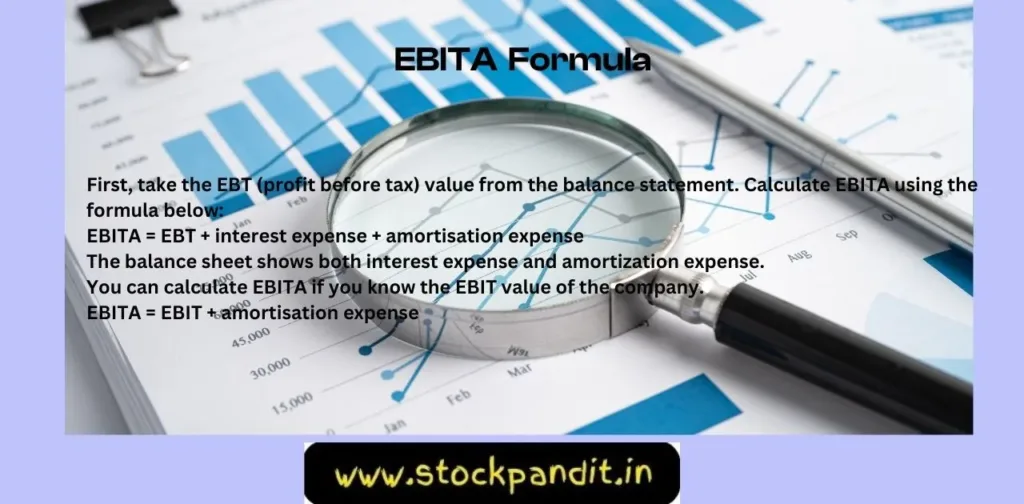EBITA: A Comprehensive Guide to Evaluating Companies’ Cash Flow
EBITA Meaning in Finance-5 Important Points: EBITA can be used to evaluate the cash flow for a business. Companies use this figure to compare their performance with that of the previous year or with other companies. Investors are interested in the value because they can use it to determine how much dividends will be paid. Here’s how to calculate EBITA, and what a fair value is.
EBITA: A Journey of Self-Discovery Image
EBITA is an acronym for earnings before taxes, interest and amortization. Calculate the ratio to determine the cash profitability of an organization. The ratio is used to compare companies within the same industry.
EBITA provides a more accurate picture of a firm’s economic strength, as tax liabilities, interest payments and amortization of intangible assets do not enter into the calculation.
EBITA provides a reliable measure of a firm’s cash flow. It shows how much cash is available for dividends or investments. Investors are also interested in EBITA because it allows them to compare companies.
You May Also Like: What is The Book Value of a Share
Exploring the Differences Between EBITDA and EBITA
Depreciation is deducted in addition to tax, interest, and amortization of intangible assets.
Both EBITA (EBITDA) and EBITA are useful ratios when it comes to a company’s liquidity. EBITDA is a better ratio to use for companies with high investments in plant, equipment and property.
Both EBITA (EBITDA) and EBITA (EBITA-Operating Income Taxes) are comparable values when a company only has low investment costs for tangible assets. They can be used to measure the performance of a business.
You May Also Like: How to Invest in Nifty 50 ETF 2024
EBITA vs. EBIT: A Comprehensive Comparison Image
The EBIT value is the operating result for a business, i.e. The EBIT value represents the operating result of a company, i.e. It reflects income from operating businesses. EBIT shows how efficient a business is at its core. EBITA, on the other hand, only targets a firm’s cash flows and measures its investment power.
A company with a high amortization rate of intangibles may have a smaller budget for their operations. This can result in a low EBIT. If one only looked at the EBIT, they might think the company was in a bad situation.
If one calculates the EBITA, however, it becomes clear that the allegedly poor operating budget was merely a result of high capital expenditures and is not a reason for concern.
The Easiest Way to Calculate EBITA: EBITA Meaning in Finance-5 Important Points
The balance sheet of the company or any other document that contains the relevant information is needed to calculate the EBITA. The EBITA ratio is not disclosed by companies, so other ratios are used to calculate it.
EBITA: Formula

First, take the EBT (profit before tax) value from the balance statement. Calculate EBITA using the formula below:
EBITA = EBT + interest expense + amortisation expense
The balance sheet shows both interest expense and amortization expense.
You can calculate EBITA if you know the EBIT value of the company.
EBITA = EBIT + amortisation expense
You May Also Like: How to Learn Trading-Avoid 5 Mistakes
Uncovering the Secrets of the EBITA Margin
It can be used in addition to the EBITA value to calculate key figures that illustrate a particular issue, such as the EBITA cover amount.
EBITA margin = EBITA / revenue
The EBITA is calculated about turnover. It gives a percentage of the turnover. This shows the amount of revenue generated before deducting taxes, interest or depreciation.
The EBITA cover amount indicates how high cash earnings are compared to turnover. Cash profitability is a function of turnover, so it’s easy to compare companies in the same sector. It is also possible to compare companies with very different turnovers.
Why Is a Good EBITA Important ?
This question is not a simple one. Since EBITA is a measure of cash flow, different companies have different cash needs, which affects the EBITA value.
In the early stages of a startup, investment costs are high. There is little cash, and this can lead to a negative (or low) EBITA.
The EBITA of established companies that no longer need to invest heavily will be higher. A coverage of 10% EBITA is considered good.
The higher the EBITA cover amount, the more free cash is available. Investors, for instance, will select the company with the highest EBITA coverage if they are comparing companies in the same sector. This is because the dividends there can be higher.
FAQs:
What makes a good EBITA?
EBITDA is a relative term, as it is dependent on the industry of the company. However, an EBITDA ratio of 10 or more can be considered to be good.
A higher margin means lower operating costs relative to total revenue. However, a margin that is low or below average indicates cash flow problems and poor profitability.
How to calculate EBITA ?
EBITA = Net income + Interest + Taxes + Amortization
This method is simple to calculate since all of the items above are on the income statement.
How is EBITDA calculated ?
EBITDA is a measure of core profitability. EBITDA can be calculated by by adding the expenses of interest, taxes, depreciation and amortization.
Are EBITA and EBIT identical ?
EBITDA and EBIT are both measures of profitability for a company’s main business operations. The main difference between EBIT and EBITDA is EBIT subtracts depreciation from the net profit, while EBITDA doesn’t.
Is EBITA the same as net profit ?
EBITDA represents net income before depreciation and amortization costs, taxes, interest, and other expenses. EBITDA is almost always higher than net profit. We’ve also seen that there are some other important differences. Net income is part of EPS while EBITDA indicates a company’s earnings potential.
Is EBITA a margin of profit ?
EBITDA is the operating profit of a business, expressed as a percent of revenue. EBITDA is Earnings Before Taxes Depreciation Amortization and Interest that a business makes.
Is EBITA profit or revenue ?
EBITDA is a measure of a company’s revenues, but some costs and expenses have been subtracted. This includes only net income, as well as non-operational costs such interest, taxes, depreciation and amortization. Revenue is the earnings that are left after all costs and expenses have been deducted.
Who uses EBITA ?
Financial Institutions
The EBITDA is used by to determine how much cash a company can pay to cover long-term debt. It is also used by banks to calculate the debt coverage ratio of a company, another way to measure its ability to pay debts. Cao says that “EBITDA” is used widely in the financial sector.
Why Is EBITDA Used In Business ?
EBITDA is used to analyze the operating profitability of a company before it incurs non-operating costs like interest, non-core expenses, and non-cash charges such as depreciation or amortization.






